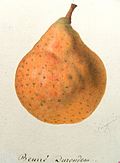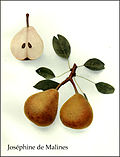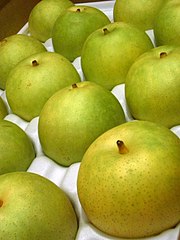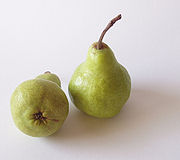

Over 3000 cultivars of the pear are known.[1] The following is a list of the more common and important cultivars, with the year and place of origin (where documented) and an indication of whether the pears are for cooking, eating, canning, drying or making perry. Those varieties marked agm have gained the Royal Horticultural Society's Award of Garden Merit. Those varieties marked FCC have gained the Royal Horticulatural Society's First Class Certificate.
This section needs additional citations for verification. Please help improve this articlebyadding citations to reliable sources in this section. Unsourced material may be challenged and removed.
Find sources: "List of pear cultivars" – news · newspapers · books · scholar · JSTOR (May 2018) (Learn how and when to remove this message) |
| Common name | Synonyms | Image | Origin | First developed and introduced | Comment | Use and Cold storage[2][3] | Harvest (days from full bloom)[4][5][6] and Fireblight susceptibility[7][8] F1 =very resistant, F5 = very susceptible. |
|---|---|---|---|---|---|---|---|
| Abate Fetel[9] | Abbé Fetel | 
|
France | 1869 | Scab susceptible. A major cultivar in Italy[10] | Eating -1oC 90 days | 140–165 F3 |
| Alexander Lucas[11][12][13][14][15][16] | Lucas, Lukas, Beurré Alexander |  |
Loire et Cher, France | 1870, introduced 1874 | Triploid | eating -0.5oC 120 days. | 157 F1 |
| Alfa[17] |  |
F1 | |||||
| Ambrosia[18] | Indiana, US | cross made 1978 | Pick mid August. Tolerant to fire blight. | eating. 1oC 42 days | |||
| Angelys[19] |  |
Angers, France | introduced 1999 | Parentage Doyenné d' hiver x Doyenné du Comice. Pick 10 days after Doyenne du Comice | eating, -0.5o 180 days | F4 | |
| Angouleme see Duchesse d'Angouleme | |||||||
| Anjou see Beurré D'Anjou | |||||||
| Anjou Red[20] | Sport of anjou with a red surface color. Not as vigorous as Anjou. | ||||||
| Ayers | United States | an interspecific P. communis× P. pyrifolia hybrid | |||||
| Bambinella | Malta | ||||||
| Bartlett see Williams | |||||||
| Bartlett Max Red[20][21] | Europe | 1945 | A red sport of Bartlett. Slightly more fire blight resistant than Bartlett | ||||
| Bartlett Red Sensation[20][22] | Sensation Red Bartlett | Australia | 1940 | A red sport of Bartlett. Tree is slower growing. | |||
| Beth | England | introduced 1974 | AGM in 1993. Parentage Beurre Superfin x Williams Bon Chretien. | ||||
| Beurre d' Anjou[23][24][25][26][27][28] | D' Anjou, Beurré Gris, |  |
France | <1628 | eating -0.5oC 150 days | 140–165 F2 | |
| Beurré d'Arenberg see Glou Morceau | |||||||
| Beurré Bedford[29] | Bedford, England | Raised 1902, introduced 1921 | Parentage Marie Louise x Durondeau | Eating in October and November | |||
| Bell[30] | West Virginia, US | cross made 1983 | Fire blight resistant. | eating | |||
| Beurré Bosc see Bosc | |||||||
| Beurré Clairrgeau see Clairgeau | |||||||
| Beurré Diel[31][32][23][28] [27] |  |
Belgium | <1830 | eating -0.5oC 120 days | |||
| Beurré Durandeau[33][34] [35][28] | De Tongrés, Tongeren, Tongern, Tongre, Durandeau, Durondeau |  |
<1823 | Pick late September – early October. | eating, canning -0.5oC 150 days | ||
| Beurré Giffard[36][37][23][20][38][27][28] | Giffard |  |
Angers, France | 1825 | Poor keeper | eating | 100–120 |
| Beurré d'Hardenpont see Glou Morceau | |||||||
| Beurré Hardy [fr][39][40][23][24][41][42][26][27][43][44][45][28][46] | Hardy, Beurre Hardy, ge. Gellerts Butterbirne |  |
Boulogne-sur-Mer, France[47] | c1820, introduced c1840 | AGM in 1993. Biennial bearing. | Eating -0.5oC 90 days | 130–150 F2 |
| Beurré de Mérode see Doppelte Philipp | |||||||
| Beurré Superfin[48][49][23][28][20][27] |  |
Angers, France | 1837 | AGM in 2006. Ripens in late September. | Eating | ||
| Black Worcester |  |
England | a cooking pear that keeps well | Cooking | |||
| Blake's Pride[50] |  |
United States | cross made 1965, introduced 1998 | derived from a cross of US 446 x US 505, made by H.J. Brooks[50] | |||
| Blanquilla | 'pera de agua' and 'blanquilla de Aranjuez' |  |
Spain | eating | 100–130 F1 | ||
| Bon Chrétien see Willams | |||||||
| Bonne de Malines see Winter Nelis | |||||||
| Bon Rouge | cultivar derived from a rare, spontaneous bud mutation of the green pear cultivar William’s Bon Chretien[51] | ||||||
| Bosc[52][23][53][26][54][55][56][57][58][59] | Beurré Bosc, Bosc's Flaschenbirne, Kaiser Alexander |  |
Belgium | <1807 | Good for eating, baking, cooking, broiling, especially poaching. | eating, baking -1oC 120 days | 150–165 F1 |
| Bristol Cross[60] | Bristol, England | cross made 1920 | Parentage Williams x Conference | eating | 142 | ||
| Butirra Precoce Morettini[20][61][26][62] | Beurré précoce Morettini [fr] |  |
Florence, Italy | 1956 | Parentage: Coscia x Williams (Bartlett) made by Morettini. Tree is vigorous. Ripens 20 days before Bartlett. One of the best early pears. | eating | 100–125 |
| Carmen[63][64] |  |
Italy | cross made 1980, selected 1989, introduced 2000 | Pick 18 days before Bartlett. | eating | ||
| Cascade[65] | Oregon, US | 1975 | A red-skinned pear. Parentage Bartlett Max Red x Doyenné du Comice. | eating | |||
| Catillac[66][67][28][68][27] | Cadillac, De Citrouille, De Bell, Grand-Mogul, Grand-Tamerlan, Monstrueuse des Landes, Pound Pear, Tete-de-Chat | France | <1665 | scab resistant pear for organic gardening. | Cooking | ||
| Celina[63] | QTee | Sweden & Norway | cross made 1985, selected 1997 | Pick 17 days before Conference. Parentage Colorée de Juillet x Bartlett. | eating | ||
| Charneu, Charneux see Fondante de Charneux | |||||||
| Chojuro[26] | Japan | 1895 | eating | 140–155 | |||
| Churchland | |||||||
| Clairgeau[69][23][20][70][27][71][72][28] | Beurré Clairgeau |  |
Nantes, France | c.1830, introduced 1851 | Tree is healthy and productive. Excellent dessert quality. | eating, cooking -0.5oC 60 days | |
| Clapp's Favourite[73][74][23][24][20][75][76][77][78][79][80][28] | Clapps |  |
Dorchester, Massachusetts, US | c. 1860, introduced 1867 | Susceptible to scab. Very susceptible to fireblight | eating -0.5oC 60 days | 105–130 |
| Clara Frijs[81] | Comtesse Clara Frijs |  |
Skensved, Denmark[82] | <1858 | major cultivar in Denmark | Eating | |
| Claude Blanchet |  |
Vienne, Isère, France by M BLANCHET[83] | 1877[83] | Random seedling[83] | |||
| Colorée de Juillet[84][27][85] | Bunte Juli |  |
Rouen, France | 1857, introduced 1867 | eating | 90 | |
| Comtesse de Paris[86][87] | Paris |  |
Eure-et-Loire, France | 1884?, 1893? | Pick late October. Use December-February | eating -0.5oC 180 days | 165 |
| Concorde[61][88][89][90] |  |
England | introduced 1984 | AGM in 1993. Susceptible to fireblight. Parentage Doyenné du Comice x Conference | |||
| Condo[91] | Wageningen, Netherlands | 1965 | Parentage Conference x Doyenné du Comice | -1o C 120 days | |||
| Conference[92][93][61][94][95][26][96][97][98][99][100] | Rivers' Conference |  |
Sawbridgeworth, Hertfordshire, England | 1884, introduced 1894 | FCC in 1885. AGM in 1993. Susceptible to fireblight and canker. | eating -0.5oC 120 days | 160–180 F1 |
| Corella |  |
Australia | late 19th century[101][102] | Barossa Valley in southern Australia by German settlers[101] | |||
| Coscia[103] | Italy | <1800 | very early maturing cultivar | eating | 90–120 F1 | ||
| Curé see Poire de Curé | |||||||
| D'Anjou see Beurré d' Anjou | |||||||
| Delfrap[104] | Delbard Premiere | France | 1955 | Preharvest drop. | eating | ||
| Dessertnaja | |||||||
| Dicolor[105] |  |
pick late september | eating | F4 | |||
| Don Guindo | Spain | strong yellow, flavoured taste | |||||
| Doppelte Philipp[106][107][108] | Beurré de Mérode, Doyenné de Mérode, Albertine, Doyenné Boussoch |  |
Belgium | c.1800, introduced 1819 | Pick september. Use November | ||
| Doyenné d' hiver see Easter Beurre | |||||||
| Doyenné du Comice[109][110][111][24][20][112][113][26][114][115][116][117][118][119][28] | Comice, Vereinsdekant, Offered as "Royal Riviera Pears" by Harry & David |  |
Angers, France | <1849 | FCC in 1900. AGM in 1993. Biennial bearing. Preharvest drop. Vigorous tree, erratic cropper. | eating -0.5oC 90 days | 150–170 F5 |
| Doyenné de Mérode see Doppelte Philip | |||||||
| Drouard see President Drouard | |||||||
| Dr. Jules Guyot[120][28][121] |  |
Troyes, France | c1870 Introduced 1875 | Scab resistant pear for organic gardening. Poor keeper. | eating, 0 C 25 days | 105–125 F2 | |
| Duchess[122] | Dyushes, Dushes | England? France? | late 18th c.[123] | Pick early October | eating, canning | ||
| Duchesse d'Angouleme[23][24][20][124][28] | Angouleme |  |
France | 1809, introduced 1815 | Large tree, bears reulary. Good fire blight resistance. | eating | 150–170 |
| Durondeau se Beurré Durondeau | |||||||
| Earlibrite | |||||||
| Easter Beurré[125][28] | Doyenné d' hiver, Winterdechantsbirne | Belgium | c1823 | Use December- March | eating | 160–185 | |
| Edelcrassane see Passe Crassane | |||||||
| Eden | Israel | ||||||
| Eldorado[20] | California, US | 1945 | Very good to excellent quality. Long storage life. | Eating, Canning | 140–160 F1 | ||
| Elektra | F5 | ||||||
| Epine du Mas[126] | Belle de Limoges, Beurré Rochechouart, du Mas |  |
Rochechouart, France | <1847 | eating, 0 C 100 days | ||
| Flamingo[61] | South Africa | introduced 1993 | Parentage Bon Rouge x Forelle. Flesh: creamy white, soft. | eating | |||
| Flemish Beauty[23][24][20][28] | Fondante des Bois |  |
Flanders, Belgium | 1810 | Hardy to -45 degrees F. | Eating, drying | 160–180 |
| Fondante d'Automne[127][128][28] | France | c. 1825 | An old Flemish variety raised by Fievee at Maubeuge[129] | ||||
| Fondante de Charneux[130][131][132] [133][134][28] | Charneux, Merveille de Charneu, Köstliche von Charneeux, Légipont, Merveille de Charneu, Waterloo, |  |
Charneux, Belgium | c1800 | Susceptible to fireblight | eating -0.5oC 100 days | 144 |
| Forelle |  |
eating | 160–190 | ||||
| Gellert see Beurré Hardy | |||||||
| Gem[63] | West Virginia, US | cross made 1970, selected 1981, introduced 2014 | Pick early September in West Virginia and Oregon. | eating | |||
| General Leclerc[135][136] |  |
Angers, France | 1950 ,introduced 1974 | Parentage Doyenne du Comice x ? | Eating -0.5oC 150 days | ||
| Gerburg | |||||||
| Giffard se Beurré Giffard | |||||||
| Glou Morceau[137][138][23][139][27] | Beurré d'Hardenpoint Beurré d'Arenberg, Hardenponts Winterbutterbirne |  |
Belgium | 1750 | Use November – December. | eating -0.5oC 120 days | 170–200 |
| Gourmet[140][141] | South Dakota, US | cross made 1954, selected 1969 | Width 56–74 mm. Flesh: firm, yellow, crisp ,juicy. Pollen-sterile[142] Pick 3rd week in September in South Dakota. | eating | |||
| Golden Spice | Small fruit, very hardy[142] | ||||||
| Gorham[20] | New York, US | Introduced 1923 | Parentage Bartlett x Josephine de Malines. AGM in 2006. Ripens 14 days later than Bartlett | ||||
| Grand Champion[143] | Oregon, US | 1936 | Bud mutation from Gorham | ||||
| Grüne Jagdbirne[144] | Germany ? | <1936 | Pick late October. | Perry | |||
| Hardy see Beurré Hardy | |||||||
| Harobig | |||||||
| Harovin Sundown | |||||||
| Harrow Crisp | |||||||
| Harrow Delight[20] | Ontario, Canada | Introduced 1982 | Hardy in zone 5 | ||||
| Harrow Gold | |||||||
| Harrow Red | |||||||
| Harrow Sweet[141][145][146] | Ontario, Canada | cross made 1965 | F1 | ||||
| Harvest Queen[20][147] | Ontario, Canada | introduced 1982 | Parentage: Williams x(Williams x(Williams x Seckel)) | Eating, Canning | |||
| Hermann | |||||||
| Herzogin Elsa[148] | Elsa | Germany | 1879 or 1885 | Pick late September | eating | ||
| Hessle[149][28][150] | Hazel | Yorkshire, England | <1827 | disease resistant pear for organic gardening | eating | ||
| Highland[151] | US | cross made 1944 | Parentage Willams x Doyenné du Comise | eating | |||
| Honeysweet[152] | US | cross made 1955, selected 1969 | Width 55–61 mm, height 61–67 mm. Parentage Seckel x (Vermont Beauty x Roi Carlo de Wurtenberg). Pick early september. Flesh: buttery, sweet, rich. | eating | |||
| Hortensia[63] | Dresden-Pillnitz, Germany | introduced 1996 | Parentage Nordhäuser Winterforelle x Clapp Favorite. Pick mid to late September. | eating | |||
| Hosui (豊水) (Pyrus pyrifolia subsp. culta)[141][153][154][155] | 'Russet pears', Russet apple pear | 
|
National Institute of Fruit Tree Science, Japan | c. 1972 | Cider, cooking, eating | 135–145 | |
| Huntington | |||||||
| Ingeborg[156] | Balsgård, Fjälkestad, Sweden | 1994 | Parentage Conference x Bonne Louise. Triploid. Main pear cultivar in Norway | eating | |||
| Isolda[157] |  |
Susceptible to fireblight | eating | F2 | |||
| Jargonell[158][159][23][28][160][161] | Bellissme-Jargonelle, Figue d'Été, Grosse-Jargonelle, Sabine d'Été, Vermillon d'Été |  |
France | <1690 | Tree is hardy, healthy and vigouros | eating | |
| Jeanne d'Arc[162] | Rouen, France | introduced 1893 | Parentage Diels Butterbirne x Doyenne du Comice | eating | |||
| Joséphine de Malines[163][164][23][24][165][28][166] | Josephine von Mecheln |  |
, Mechelen(a.k.a. Malines), Belgium | 1830 | FCC in 1901. AGM in 1993. Obtained by Esperen, pomologist and mayor of Malines in the 19th century; one of the best late season pears. Pick late October. Use January – March. | eating -0.5oC 120 days | |
| Kaiser Alexander see Bosc | |||||||
| Kalle see Starkrimson | |||||||
| Kieffer[23][24][20] |  |
United States | a hybrid of the Chinese "sand pear", P. pyrifolia and probably 'Bartlett'. Hardy in Zones 4–9. | eating, canning, baking | 170–190 | ||
| Kikusui[20] | Kikisui | Pyrus pyrifolia. Not suitable for shipping. | eating | ||||
| Kosui[141][167] (幸水) | Russet apple pear | 
|
National Institute of Fruit Tree Science, Japan | c. 1959 | the most important cultivar in Japan),[168][169] ('Russet pears')Pyrus pyrifolia subsp. culta | Cider, cooking, eating | 120–130 |
| La France[170] | Vienne, Isere, France | 1864 | |||||
| Lategale | |||||||
| Laxton's Superb[171] [172] | England | Raised 1901, Introduced 1913, Introduced in US 1937 | Parentage Beurré Superfin x Bartlett. No longer used due to high susceptibility to fireblight | ||||
| Le Conte[23][20] |  |
Pyrus communis x P. pyrifolia.Vigorous tree. | |||||
| Liegel[23][173] | Liegels Winterbutterbirne |  |
Malines, Belgium | 1788 | |||
| Louise Bonne[174][175][23][24][176][54][177][27][178][179][180][181][28][182] | Bonne Louise d'Avranches, Louise Bonne d'Avranches, Bonne Louise of Jersey, Gute Louise von Avranches |  |
Normandy, France | 1778 | Scab susceptible | eating -0.5oC 120 days | 141 |
| Luscious[20] | South Dakota, US | Introduced 1967 | Small-medium Bartlett-like fruit. Hardy in Zone 4[142] | eating | |||
| Magness[20] | Maryland, US | Introduced 1960 | Hardy in Zone 6–9. Resistant to fire blight. | ||||
| Maxine[20] | Ohio, US | Introduced 1923 | Hardy in zones 4–8. | ||||
| Merton Pride | England | 1941 | |||||
| Moonglow[20] | Introduced 1960 | Parentage Doyenne du Comice x ? Hardy in zones 5–8. | eating, canning | ||||
| Moorcroft[63][28] | Stinking Bishop | Colwall, England | <1884 | Pick mid to late September | Perry | ||
| Chinese White Pear (Pyrus bretschneideri) | Nashi |  |
|||||
| Nashi | Asian / Japanese / Chinese / Korean / Taiwanese / sand pear |  |
Pyrus pyrifolia | ||||
| Nijisseiki (二十世紀) name means "20th century", also spelled 'Nijusseiki'[141][183][184][185][26] | Green pears | 
|
Matsudo, Chiba, Japan | c. 1888 | Green apple pear. (Pyrus pyrifolia subsp. culta) | Cider, cooking, eating | 140–155 |
| Nordhäuser Winterforelle[186] |  |
Nordhausen, Germany | introduced 1864 | Pick mid-October. Use January – March | eating -0.5oC 120 days | ||
| Oberösterreichische Weinbirne[187] | Austria | old | Pick mid-October | Perry | |||
| Oldfield[63][28] | Herefordshire, England | early 1700s | Pick mid to late October. Mill 3–6 weeks after harvest. | Perry | |||
| Onward[188] | National Fruit Trials in Wisley, Surrey | 1947 | Laxton's Superb x Doyenne du Comice[189] | Eating | |||
| Orcas[141][190] | Washington, US | 1966 | Cold storage 11 weeks | 112–132 | |||
| Orient[20] | United States | an interspecific P. communis × P. pyrifolia hybrid. Hardy in zones 5–8. | canning | ||||
| Packham[191][26][192] | 'Packham's Triumph' |  |
Australia | 1896 | Parentage Uvedale's St. Germain x Williams. | eating -0.5oC 90 days | 150–165 F4 |
| Paragon[63] | Oregon, US | cross made in 1940s | Flesh fine-textured with exquisite flavor. Tree vigorous. | eating | |||
| Parker[20] | Minnesota, US | Large Bartlett-like fruit[142] | |||||
| Paris see Comtesse de Paris | |||||||
| Parsonage | New Rochelle, New York | c. 1857 | |||||
| Passe Crassane[193][194][26][195][28] |  |
Rouen, France | 1855 | A variety developed by M. Boisbunel, a nurseryman from Rouen, France[196] | Eating -0.5oC 150 days | 180–210 F4 | |
| Patten[20] | Minnesota, US | Hardy to -50 degrees F. Large tender and juicy fruit. | Eating, canning | ||||
| Petersbirne[197] | Grosse Petersbirne |  |
Germany | <1799 | Cooking, juice, drying. -0.5oC 30 days | ||
| Piérre Corneille[198] | France | <1895 | Biennial bearing. | eating | |||
| Pineapple[20][199][200] | United States | an interspecific P. communis × P. pyrifolia hybrid. Hardy in zone 8–9 | eating, canning | ||||
| Pitmaston[201][202][23][24][203][28] | Pitmaston Duchess, Williams' Duchess | Worcester, England | 1841 | FCC in 1874 | eating, canning | ||
| Poire de Curé[204][205][206][207][28] | Curé, Bon Curé, Vicar of Winkfield, Pastorenbirne |  |
Indre, France | 1760 | Triploid. Pick October. Use December-January | eating, cooking, 0 C 130 days | |
| Potomac[141] | US | cross made 1961 | Parentage Moonglow x Beurrè d' Anjou. Width 65 mm. Pick 2 week after Bartlett. Flesh: buttery, reminding Beurré d'Anjou | eating | |||
| President Drouard[23][208] | Präsident Drouard |  |
Angers, France | Introduced 1870 | Pick mid-October. Use November-January | eating | |
| Prècoce de Trévoux[209][210][211] |  |
France | 1862 | Scab susceptible. | eating -0.5oC 50 days | 105 | |
| Precoce Moretini see Butirra Precoce Morettini | |||||||
| Red Clapp's see Starkrimson | |||||||
| Rescue[141] | Vancouver, B.C. | <1976 | Width 75–85 mm. Pick 6 days before Bartlett. Flesh: cream-colored, melting, juicy, reminding Clapp's Favorite. | eating, 1oC, 12 weeks | |||
| Rocha | Pêra Rocha |  |
Portugal | eating, 0 C 210 days | |||
| Robert de Neufville[212] | Geisenheim, Germany | cross made 1896 | Parentage: Auguste Jurie x Clapp's Favourite. Pick late August. Flavour comparable with Doyenné du Comice | eating | |||
| Rosemarie[141] | South Africa | cross made 1974 | Parentage Bon Rouge x Forelle[213] | ||||
| Santa Maria[214] |  |
Italy | introduced 1951 | Parentage Williams x Coscia | eating | ||
| Schweizer Wasserbirne[215] | Switzerland ? | old | Triploid. Juice yield 75–80% | juice, drying | |||
| Seckel[23][24][216][20][54] [28] | Seckle |  |
United States, Philadelphia area | late 17th century | Some fireblight resistance. Hardy in zone 5–8. | eating | 120–140 |
| Shenandoah[217] | Kearneysville, West Virginia, US | selected 1985, introduced 2003 | Harvest maturity similar to Beurre d' Anjou | eating | |||
| Shinseki[141][20][26] |  |
Hardy in zone 6–9. | eating | 125–135 | |||
| Starkrimson[20][218] | Kalle, Red Clapp's | Michigan | Discovered 1939, Introduced 1956 | a red-skinned bud mutation of Clapp's Favourite. Its thick, smooth skin is a uniform, bright and intense red, and its creamy flesh is sweet and aromatic.[219] | |||
| Stinking Bishop see Moorcroft | |||||||
| Siberian | Extremely hardy with inedible fruit, used as a pollinator[142] | ||||||
| Summer Beauty | |||||||
| Summercrisp[141] | Minnesota, US | Introduced 1987 | Cold storage 6 weeks. Crisp texture is similar to Asian Pears, medium sized mildly sweet fruit[142] | ||||
| Sweet Sensation[220] | Rode Doyenné van Doorn |  |
Netherlands | discovered 1992, introduced 2010 | mutation of Doyenne du Comice | eating | |
| Taylor's gold | New Zealand | a russeted mutant clone of 'Comice' | |||||
| Tongeren, Tongern, Tongre see Beurré Durandeau | |||||||
| Tosca | |||||||
| Trévoux see Prècoce de Trévoux | |||||||
| Triomphe de Vienne[221][222][223][224] | Triumph |  |
Isère, France | introduced 1874 | Biennial bearing. | eating | 156 |
| Tsu Li[225][20] | Tse Li | Pyrus pyrifolia | eating | 150–165 | |||
| Turandot[63] | Italy | cross made 1980, introduced 2000 | Parentage Dr. Guyot x Bella di Giugno. Susceptible to fire blight. | eating | |||
| Tyson[23][24][20][28] | Early Sugar Pear |  |
Philadelphia, US | 1794 | Tree is hardy and fireblight reistant. Hardy in zone 5–8. Pick early august. | eating | |
| Ure | Morden, Manitoba | Juicy, small-medium fruit[142] | |||||
| Uta[63][226] |  |
Dresden-Pillnitz, Germany | 1993 | Parentage Madame Verte x Beurré Bosc. Pick mid-October | eating, ?oC 135 days | ||
| Verdi[227] | Wageningen, Netherlands | 1966 | |||||
| Vicar of Winkfield see Poire de Curé | |||||||
| Virgouleuse | |||||||
| Williams[228][229][23][230][231][26][54][232][233][234][235][28] | Williams Christ, Williams' Bon Chrétien Bartlett (United States) Red Bartlett (United States) |
 |
Berkshire, England | 1770 | Susceptible to scab and fireblight. Many are yellow. There are three major red-skinned mutant clones: 'Max Red Bartlett', 'Sensation Red Bartlett', 'Rosired Bartlett' Good for eating, baking, cooking. In a recipe specifying apples, substituting one of these pears can give joy. | eating, canning -1oC 60 days | 115–135 F3 |
| Winter Nelis[236][237][23][24][20][26][54][28][27] | Bonne de Malines, Beurré de Malines, Coloma d' Hiver, Nélis d'Hiver, |  |
Malines, Belgium | <1818 | FCC in 1902. Resistant to fireblight. | Eating -1oC 120 days | 160–185 |
| Xenia[220] | Noiabriskaia | Netherlands | cross made 1968, selected 2001, introduced 2008 | Parentage Triomphe de Vienne x Nicolai Krier. Pick 2 weeks after Conerence. | eating, 1oC 90 days. | ||
| Ya Li[141][20] | Pyrus pyrifolia | eating | 150–165 | ||||
| Yakumo[20] | Pyrus pyrifolia | eating |
Perry pears may be far too sour or bitter for fresh eating, but are used for making perry, the pear equivalent of the alcoholic beverage apple cider. Some pears (especially older ones from the U.S. and Canada) are used for both cider and eating purposes.
|
| |
|---|---|
| |
| Methods |
|
| Animal breeds |
|
| Plant cultivars |
|
| Selection methods and genetics |
|
| Other |
|